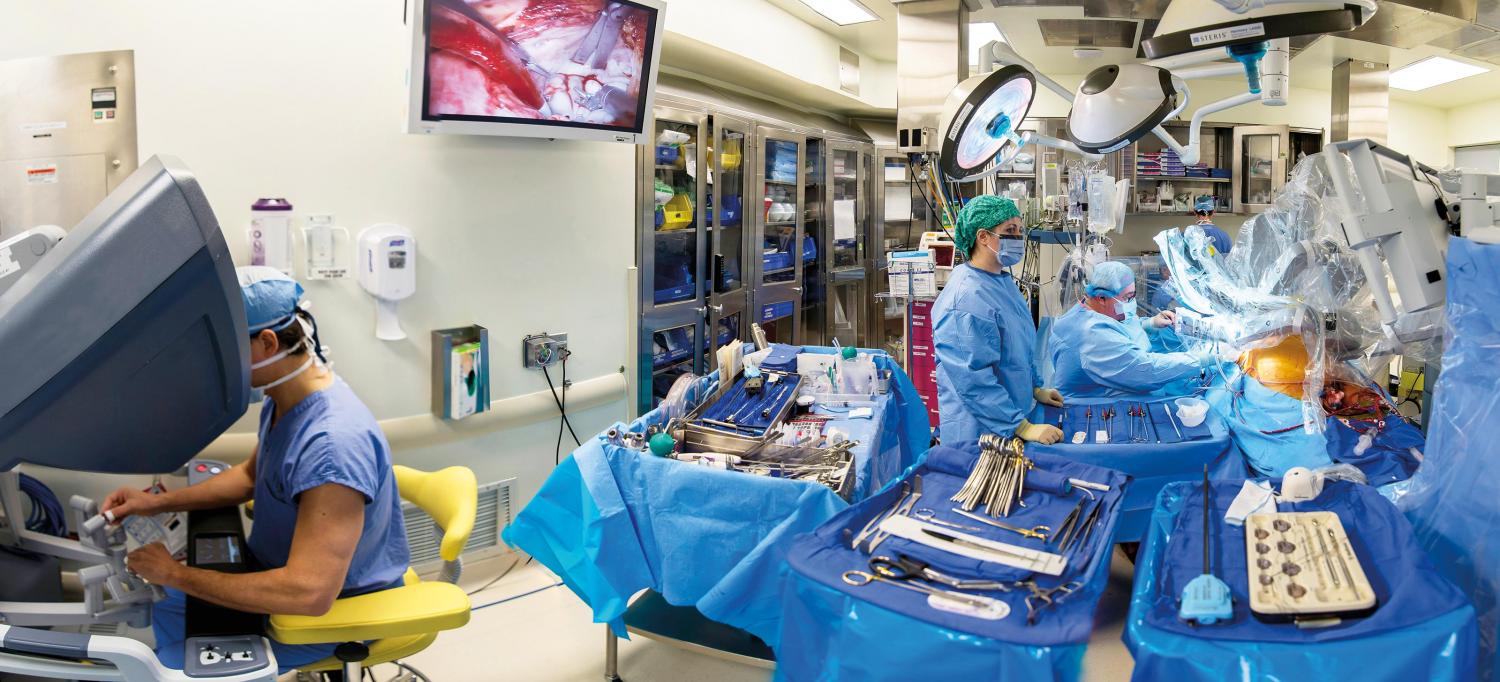
Didier F. Loulmet, MD (at console), and Eugene A. Grossi, MD (with patient on right).
Photo: NYU Langone Staff
NYU Langone became the first U.S. academic medical center to implant the newly FDA-approved CoreValve® Evolut™ R Heart Valve for severe aortic stenosis in July 2015. In a transcatheter procedure, Mathew R. Williams, MD, associate professor of cardiothoracic surgery and medicine, chief of the Division of Adult Cardiac Surgery, director of Interventional Cardiology, and director of the Heart Valve Center, implanted this next-generation heart valve, which is recapturable and repositionable and which can be implanted in patients for whom surgery is considered high risk.
“Most patients start to feel better immediately after the procedure, and many can leave the hospital in one or two days,” says Dr. Williams, who has performed nearly 2,000 transcatheter aortic valve replacements (TAVRs)—more than any other surgeon in the United States—and was the national primary investigator in the Evolut R Study.
The center is further improving TAVR outcomes by using conscious sedation. The team worked closely with Peter J. Neuburger, MD, assistant professor of anesthesiology, who led the development of the sedation protocol for TAVR patients. Now, more than 90 percent of TAVR patients at NYU Langone undergo conscious sedation rather than general anesthesia. “These patients are up and walking within four hours and have an average hospital stay of less than two days,” says Dr. Williams.
The volume of TAVR procedures performed at the Heart Valve Center increased over the past year, from 51 in 2014 to more than 200 in 2015. At the same time, the center upheld the highest safety and quality standards, with a 2015 in-hospital TAVR mortality rate of 1.3 percent, a 30-day readmission rate of 16 percent, and more than 90 percent of TAVR patients discharged home rather than to a long-term care facility, compared with national rates of 4 percent for mortality, more than 25 percent for readmissions, and about 68 percent discharged home.
Imaging in TAVR
State-of-the-art imaging has played an essential role in the trend toward using TAVR procedures. NYU Langone has advocated for switching from using the more invasive transesophageal echocardiography (TEE) in TAVR procedures to using the less invasive transthoracic echocardiography (TTE), which does not require general anesthesia, making it less risky for patients. “TEE in a 40-year-old is fine, but most TAVR patients are in their eighties and above, and frail, so we avoid anything invasive whenever we can,” says Muhamed Saric, MD, PhD, associate professor of medicine and director of the Echocardiography Laboratory.
In 2011–13, TEE was used in all TAVR procedures at NYU Langone. By late 2015, 94 percent of TAVR procedures were performed using TTE instead. “Although TEE generally provides a more detailed image, TTE provides sufficient diagnostic information for the procedure while minimizing both discomfort and risk,” says Dr. Saric. “And since the patient does not need to recover from general anesthesia, the recovery period is also shorter.”
Dr. Saric and his colleagues documented the evidence for using TTE in TAVR procedures in their March 2015 article in the Journal of the American College of Cardiology.
Real-time collaboration between cardiac surgeons, interventional cardiologists, anesthesiologists, and echocardiographers, combined with the use of high-quality CT scans, is a hallmark of the center’s Heart Valve Program, Dr. Saric says. “Traditionally, TTE has been performed by sonographers and subsequently interpreted by cardiologists. In the Heart Valve Program, cardiac imaging subspecialty physicians, including Ricardo J. Benenstein, MD, assistant professor of medicine, and Alan F. Vainrib, MD, instructor of medicine, perform the scans and provide on-the-spot expert feedback during the procedure. This teamwork and integration of knowledge significantly enhance patient care.”
Transcatheter Mitral Valve Repair and Replacement
This year NYU Langone expanded on its minimally invasive mitral valve repair options through the increased performance of transcatheter mitral valve repairs, also known as mitral clip procedures, which provides an option for patients who are not ideal candidates for surgery. The number of transcatheter mitral valve repairs performed at NYU Langone rose from 12 in 2014 to more than 50 in 2015, making it the busiest center in the region. Most patients are able to return home within one day after the procedure. In select cases, the team has even replaced mitral valves via a transcatheter approach.
Robotic Surgery—Reducing Intubation Time
Didier F. Loulmet, MD, associate professor of cardiothoracic surgery, chief of Cardiac Surgery at Tisch Hospital, and director of Robotic Cardiac Surgery, is one of the world’s leading experts in using robotic surgery to perform mitral valve repairs. Always seeking to improve quality of care and reduce complications, Dr. Loulmet has set new standards for early extubation of mitral valve surgery patients over the past year. “Early extubation decreases ICU time and improves recovery time,” says Aubrey C. Galloway, MD, the Seymour Cohn Professor of Cardiothoracic Surgery and chair of the Department of Cardiothoracic Surgery. Patients who are off respiratory equipment and intensive monitoring earlier are able to ambulate and recover more quickly. Seventy percent of Dr. Loulmet’s robotic patients are now extubated before they leave the operating room; most of the remaining 30 percent are extubated within six hours of surgery. Dr. Galloway suggests that across all cardiac surgery, extubation within six hours sets a new benchmark for quality and that because NYU Langone has systematically prioritized early extubation, its percentages are among the best in the country.

